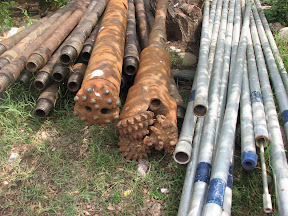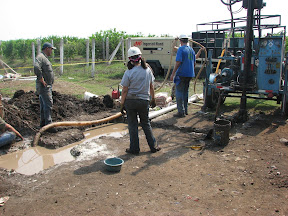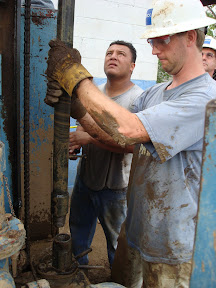El Salvador :: The Work – part 1
posted May 27th, 2008 by George
. . . I choose to go because these children are loved by God just as much as my own children, and they have just as much of a right to clean water as my children do.
 Many people have been curious about the specifics of the drilling work we were doing in El Salvador.
Many people have been curious about the specifics of the drilling work we were doing in El Salvador.
 First of all, in order to drill for water, you need a lot of water. That sounds funny, but we had to pump water down the drill pipe and out the end of the drill bit. This serves several purposes. It keeps the drill bit cool, helps to soften the dirt, and pushes up all the cuttings back to the surface. So, we drove to the river and filled several barrels with not-so-clean water. There were many women and children at the river doing laundry and fetching water as well.
First of all, in order to drill for water, you need a lot of water. That sounds funny, but we had to pump water down the drill pipe and out the end of the drill bit. This serves several purposes. It keeps the drill bit cool, helps to soften the dirt, and pushes up all the cuttings back to the surface. So, we drove to the river and filled several barrels with not-so-clean water. There were many women and children at the river doing laundry and fetching water as well.
 We also have to dig a couple of pits. Fortunately, one of the local men had already dug the pits for us when we arrived. Next we had to seal the pits with mud and bentonite. The bentonite mixed with water made a slushy mixture that reminded me of runny pudding. These pits were going to hold water for our drilling operation, so they needed be sealed up. We had some trouble with this because the ground was pretty cracked. Water kept flowing out of the pits and flowing from one pit to the other, but after some effort and a lot of mud and bentonite we got them plugged up.
We also have to dig a couple of pits. Fortunately, one of the local men had already dug the pits for us when we arrived. Next we had to seal the pits with mud and bentonite. The bentonite mixed with water made a slushy mixture that reminded me of runny pudding. These pits were going to hold water for our drilling operation, so they needed be sealed up. We had some trouble with this because the ground was pretty cracked. Water kept flowing out of the pits and flowing from one pit to the other, but after some effort and a lot of mud and bentonite we got them plugged up.
 As the drill cuts down, the cuttings flow up the hole, and down a trench into the first pit. This is the settling pit where the larger bits of rock and dirt will settle. Then the muddy water flows to the second pit where the mud pump sucks it back up and down the drill pipe for another run.
As the drill cuts down, the cuttings flow up the hole, and down a trench into the first pit. This is the settling pit where the larger bits of rock and dirt will settle. Then the muddy water flows to the second pit where the mud pump sucks it back up and down the drill pipe for another run.
 Every 5 feet of drilling we would have to add a new length of drill pipe to the rig. At this point, we would also take a soil sample of the sediment coming up so we could gage what type of material were were drilling through. This was also a good time to change shifts so half the team could rest while the other half worked in the sun. Sometimes a 5 foot section would go rather quickly (20 minutes), and other times it make take 3 hours. We must have hit some dense rock or iron ore on Monday, because it took us many hours just to go about 15 feet, but on Tuesday things really sped up and we drilled all the way down to 100 feet.
Every 5 feet of drilling we would have to add a new length of drill pipe to the rig. At this point, we would also take a soil sample of the sediment coming up so we could gage what type of material were were drilling through. This was also a good time to change shifts so half the team could rest while the other half worked in the sun. Sometimes a 5 foot section would go rather quickly (20 minutes), and other times it make take 3 hours. We must have hit some dense rock or iron ore on Monday, because it took us many hours just to go about 15 feet, but on Tuesday things really sped up and we drilled all the way down to 100 feet.
Filed under: El Salvador, Faith on May 27th, 2008
I guess I’m kind of slow – why did you have to dig the pits? And what is going on in the second picture…and the fourth picture???
The pits are used to catch the dirt and rock that is being drilled out of the shaft. The mud pump pushes muddy water down the drill stem to the drill bit. Then the water pushes the rock and dirt out to the surface. Once on the surface, the water, mud and rock flow down a trench to the first pit. The larger particles will settle to the bottom of the pit. Then the water flows to the second pit where hopefully the rest of the particles will settle. Then the water is sucked up by the pump again to go back down the drill stem.
In the Second picture we are getting water from the river. We had to have water to fill the two pits.
The fourth picture shows the the drilling operation from a few steps back. I was trying to capture the whole process. On the right you can see the drill, then a little bit of the trench to the first settling pit, then the small trench to the second pit, then finally the hose coming out of the second pit back to the mud pump.
I hope that clears it up some. I think it was pretty late when I wrote this post.
That does totally clear it up – not muddy at all anymore. (teehee – I just love a bad pun!) 🙂 Thanks for taking the time to answer my questions – so very interesting!